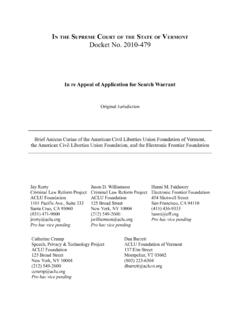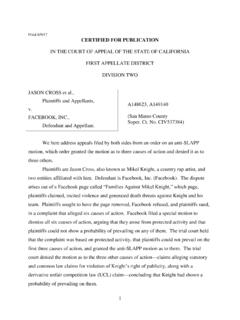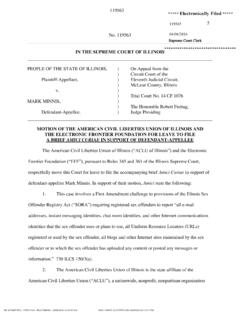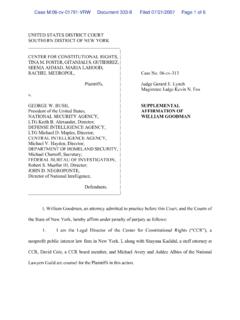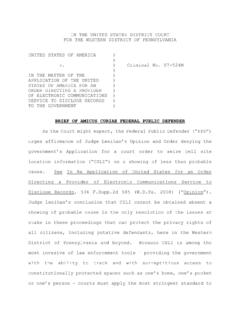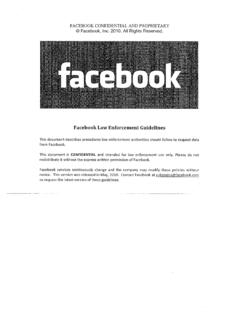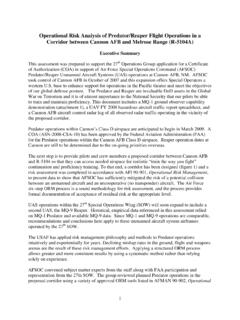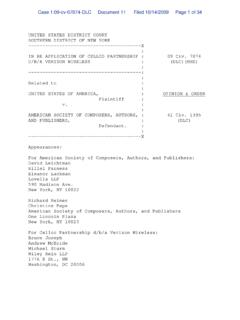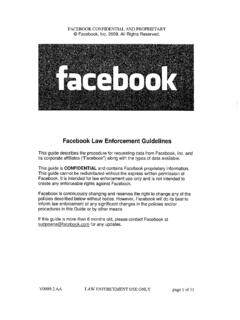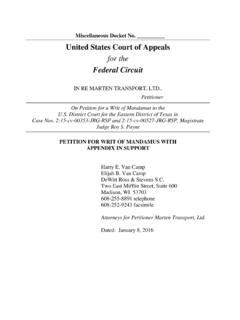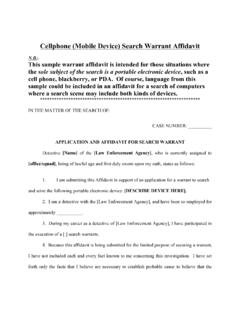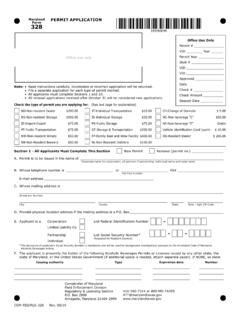Transcription of APPENDIX F: Sample Language for Search Warrants and ...
1 APPENDIX to Searching and Seizing Computers and Obtaining Electronic Evidence Page 24 of 38 (C) local and long distance telephone connection records, or records of session times and durations; (D) length of service (including start date) and types of service utilized; (E) telephone or instrument number or other subscriber number or identity, including any temporarily assigned network address; and (F) means and source of payment for such service (including any credit card or bank account number) B. The contents of wire or electronic communications held or maintained in [ISP's] computer systems on behalf of the accounts identified in Part A at any time up through and including the date of this Subpoena, EXCEPT THAT you should NOT produce any unopened incoming communications ( , communications in "electronic storage") less than 181 days old.
2 "Electronic storage" is defined in 18 2510(17) as "(A) any temporary, intermediate storage of a wire or electronic communication incidental to the electronic transmission thereof; and (B) any storage of such communication by an electronic communication service for purposes of backup protection of such communication." The government does not seek access to any such materials, unless they have been in "electronic storage" for more than 180 days. [Return to Main Text] APPENDIX F: Sample Language for Search Warrants and Accompanying affidavits to Search and Seize Computers ( APPENDIX F updated December 2006) This APPENDIX provides Sample Language for agents and prosecutors who wish to obtain a warrant authorizing the Search and seizure of computers.
3 The discussion focuses first on the proper way to describe the property to be seized in the warrant itself which in turn requires consideration of the role of the computer in the offense. The discussion then turns to drafting an accompanying affidavit that establishes probable cause, describes the agent's Search strategy, and addresses any additional statutory or constitutional concerns. I. DESCRIBING THE PROPERTY TO BE SEIZED FOR THE warrant The first step in drafting a warrant to Search and seize computers or computer data is to describe the property to be seized for the warrant itself This requires a particularized description of the evidence, contraband, fruits, or instrumentalities of the crime that the agents hope to obtain by conducting the Search .
4 Whether the "property to be sebed" should contain a description ofinformation (such as computer files) or physical computer hardware depend! on the role of the computer in the offense. In some cases, the computer hardware is itself contraband, evidence of a crime, or a fruit orinstrumentality of a crime. In these situations. Fed. R. Crim. P. 41 1/3/2008 APPENDIX to Searching and Seizing Computers and Obtaining Electronic Evidence Page 25 of 38 expressly authorizes the seizure of the hardware, and the warrant will ordinarily request its seizure. In other cases, however, the computer hardware is merely a storage device for electronic files that are themselves contraband, evidence, or instrumentalities of crime.
5 In these cases, the warrant should request authority to Search for and seize the information itself, not the storage devices that the agents believe they must seize to recover the information. Although the agents may need to seize the storage devices for practical reasons ( , the electronic media cannot be imaged without first seizing the hardware), such practical considerations are best addressed in the accompanying affidavit. The "property to be seized" described in the warrant should fall within one or more of the categories listed in Rule 41(b): (1) "property that constitutes evidence of the commission of a criminal offense" This authorization is a broad one, covering any item that an investigator "reasonably could.
6 Believe" would reveal information that would aid in a particular apprehension or conviction. Andresen v. Maryland, 427 463, 483 (1976). Cf Warden v. Hayden, 387 294, 307 (1967) (noting that restrictions on what evidence may be seized result mostly from the probable cause requirement). The word "property" in Rule 41(b)(1) includes both tangible and intangible property. See United States v. New York Tel. Co., 434 159, 169 (1977) ("Rule 41 is not limited to tangible items but is sufficiently flexible to include within its scope electronic intrusions authorized upon a finding of probable cause."); United States v. Biasucci, 786 504, 509-10 (2d Cir. 1986) (holding that the fruits of video surveillance are "property" that may be seized using a Rule 41 Search warrant ).
7 Accordingly, data stored in electronic form is "property" that may properly be searched and seized using a Rule 41 warrant . See United States v. Hall, 583 F. Supp. 717, 718-19 ( Va. 1984). (2) "contraband, the fruits of crime, or things otherwise criminally possessed" Property is contraband "when a valid exercise of the police power renders possession of the property by the accused unlawful and provides that it may be taken." Hayden, 387 at 302 (quoting Gouled v. United States, 255 298, 309 (1921)). Common examples of items that fall within this definition include child pornography, see United States v. Kimbrough, 69 723, 731 (5th Cir. 1995), pirated software and other copyrighted materials, see United States v.
8 Vastola, 670 F. Supp. 1244, 1273 ( 1987), counterfeit money, narcotics, and illegal weapons. The phrase "fruits of crime" refers to property that criminals have acquired as a result of their criminal activities. Common examples include money obtained from illegal transactions, see United States v. Dornblut, 261 949, 951 (2d Cir. 1958) (cash obtained in drug transaction), and stolen goods. See United States v. Burkeen, 350 261, 264 (6th Cir. 1965) (currency removed from bank during bank robbery). (3) "property designed or intended for use or which is or had been used as a means of committing a criminal offense" Rule 41(c)(3) authorizes the Search and seizure of "property designed or intended for use or which is or had been used as a means of committing a criminal offense.
9 " This Language permits courts to issue Warrants to Search and seize instrumentalities of crime. See United States v. Farrell, 606 1341, 1347 ( Cir. 1979). Computers may serve as instrumentalities of crime in many ways. For example. Rule 41 authorizes the seizure of computer equipment as an instrumentality when a suspect uses a computer to view, acquire, and transmit images of child pornography. See Davis V. Gracey, 111 1472, 1480 (10th Cir. 1997) (stating in an obscenity case that "the computer equipment was more than merely a 'container' for the files; it was an instrumentality of the crime."); United States v. Lamb, 945 F. Supp. 441, 462 ( Y. 1996). Similarly, a hacker's computer may be used as an instrumentality of crime, and a computer used to run an illegal Internet gambling business would also be an instrumentality of the crime.
10 Here are examples of how to describe property to be seized when the computer hardware is merely a storage container for electronic evidence: (A) All records relating to violations of 21 841(a) (drug trafficking) and/or 21 846 (conspiracy to traffic drugs) involving [the suspect] since January I, 2006, including lists of customers and related identifying information; types, amounts, and prices of drugs trafficked as well as dates, places, and amounts of specific transactions; any information related to sources of narcotic drugs (including names, addresses, phone numbers, or any other identifying information); any information recording [the suspect's] schedule or travel from 1995 to the present; all bank records, checks, credit card bills, account information, and other financial records.
